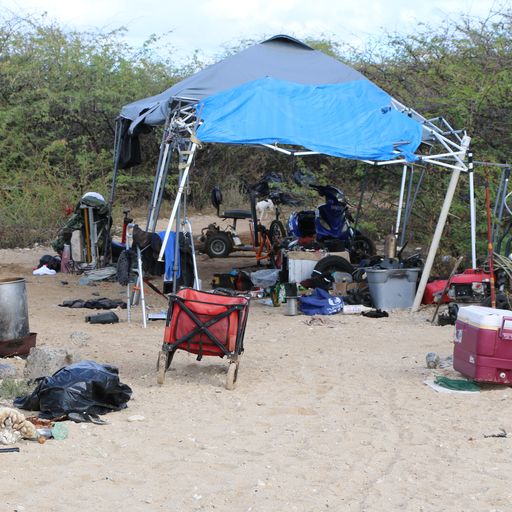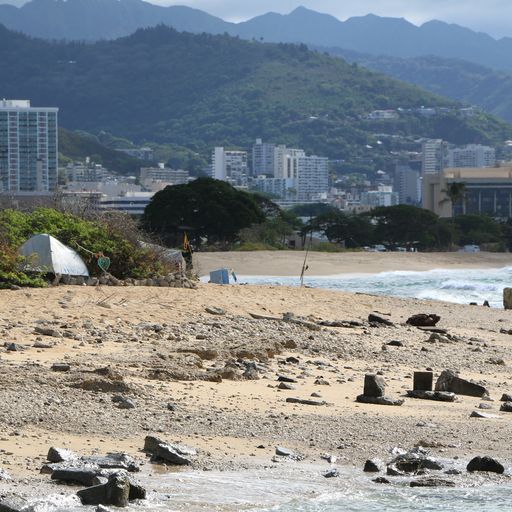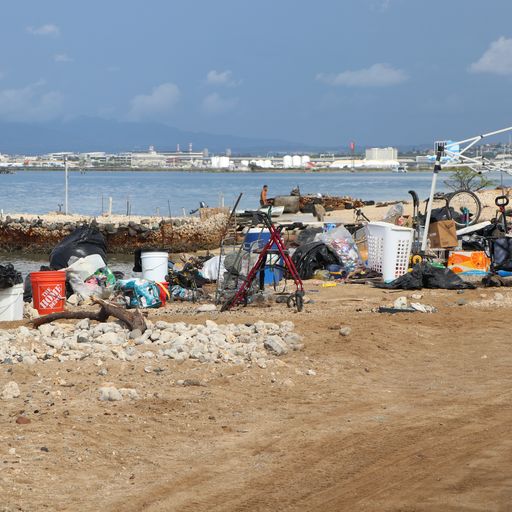Homelessness on public recreation land on Oʻahu an ongoing problem with few solutions

The shoreline on the western side of O‘ahu’s Sand Island State Recreation Area is intended to be a place for residents and visitors to fish and swim and participate in recreational pursuits.
But officials with the state Department of Land and Natural Resources say there’s a long list of challenges and few solutions when it comes to homeless individuals who have taken up residence at the urban park.
The growing population of homeless people have reduced the desire for the public to enjoy the park due to “loose dogs, frequent fights and other misconduct” associated with squatters, the department said in a news release.
“My heart goes out to these people in terms of the social impacts, the issues they have had in their lives,” said Curt Cottrell, the Administrator of the Division of State Parks. “We have created an entitled population who prefer to be camping along the shoreline or in the bushes, rather than getting offered services and housing. It’s become a lifestyle.”
The park is made up of two areas:
- One is a fairly groomed park with permitted camping sites, day use sites, softball fields and comfort stations.
- The other section of the park is an undeveloped and heavily marginalized urban wilderness, where fishermen used to go to fish and where several canoe clubs practice.
The department manages lands for the use of the public, but it says it can only do so much: “Squatters could be cited for trespass, and despite periodic clean-ups, there is no effective way to move homeless people off public lands permanently when they consistently refuse housing.”
Department officials say many of the people who were inhabiting 30 different campsites at Sand Island came from Kaka‘ako, after parks there were transferred to the City and County of Honolulu.
Clean-ups at places like Sand Island State Recreation Area and Diamond Head State Monument have resulted in high costs.
“State Parks budgeted $200,000 this year to support the Department of Transportation contracted cleanup efforts,” Cottrell said. “It’s nowhere enough. It’s a shame this is happening to some of our most beautiful locations.”
Several times each year, DLNR and its partners schedule homeless camp clean-ups. Prior to any clean-up, DLNR representatives are joined by service providers such as the Institute for Human Services, Hawai‘i Health and Harm Reduction Center, and the City and County of Honolulu’s TEAM Work Hawai‘i program.
They walk through each camp and contact each person they see to let them know clean-up crews will be on the way. Notice and outreach are provided typically 1 to 2 weeks in advance of any clean-up operation, according to DLNR.
“Even if an individual does not choose to accept shelter, involvement with service providers enables them to connect with case management and medical services,” said Scott Morishige, the Governor’s Office Homelessness Coordinator. “They also receive assistance in getting identification cards and other vital documents, as well as connections to benefits like SNAP.”
Following the notice, to gather up their belongings and move, a contractor moves in with trucks and workers to collect everything that has been left behind. If items are stored, the owners then have 30-days in which to claim any personal belongings.
“The thing we find the most challenging and egregious is the amount of rubbish that’s generated that we have to keep cleaning up,” said Cottrell. “The money we’re spending on these clean-ups could be used for park improvements and other needed projects. It’s a shame this is happening in some of our most beautiful locations. Granted, Sand Island is an urban area but with enough elbow grease and funding it could be a jewel of a park.”
The department acknowledges that while squatters are camping without authorization, being homeless in and of itself is not illegal.
Pua Aiu, DLNR’s Homelessness Coordinator, said, “Periodic, but regular operations at Sand Island and Diamond Head are not intended to be a solution to homelessness or a social service response, but are consistent with our overall mission of protecting and managing State lands and resources.”
At Sand Island, DSP is exploring “activating” the shoreline for the enjoyment of everyone, which they they hope will prevent camps from reappearing almost immediately after a clean-up.
State Representative Daniel Holt toured the area with Cottrell earlier this week and says it’s a bigger issue than he imagined. “To see this beautiful area trashed and disrespected is very tough. I feel for the people who are struggling and have to live out here in these tents, but we need both short-term and longer-term solutions to activating the space.”
Ideas include getting a nearby BMX track up and running, doing a mass clean-up of the nearshore waters, partnering with canoe clubs, and conducting daily sweeps.
“Daily sweeps would be challenging,” Cottrell says, as it would require daily staff, law enforcement and social worker commitment. “Real solutions are so hard to find, especially if people refuse housing or find campsites as safe places to do drugs. The adjacent BMX site, a great community asset, gets vandalize regularly. They just had a locker broken into and 20 bikes were stolen. Canoe clubs are expanding their activity at Sand Island but are also finding it difficult to deal with the 24/7 homeless population.”
Morishige said there is no one size fits all answer to homelessness. “However, it is important to balance enforcement efforts with connections to services and a continued focus on navigation to housing.”
In addition to having a homeless coordinator on staff, DLNR has provided land for emergency shelters and housing, including two projects at Sand Island. The Hale Mauli Ola emergency shelter is on DLNR land leased to the City and County of Honolulu, and the Kauhauiki Village housing land was transferred to the C&C, which in turned leased it to a private foundation.
“First we need to keep the area clean and then we need the community to help us envision what is the highest and best use for the park. What can the community do? They can file police reports when they see crime, or are affected by criminal acts, or are bitten by loose dogs. We encourage people to continue using the groomed parts of the park as we slowly expand use to the whole park,” said Cottrell.














